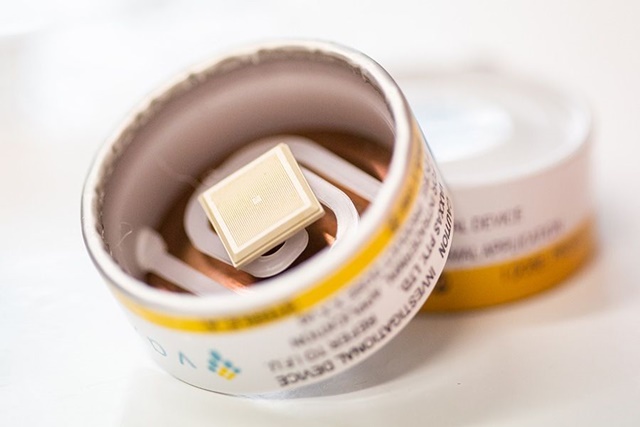31 Mar. 2023. A clinical trial shows a microneedle patch device for vaccine delivery applied by participants to their own arms works as well in the skin as when administered by clinicians. Results of the trial, testing a vaccine patch made by medical device company Vaxxas, were published 22 Mar. 2023 in the journal Human Vaccines & Immunotherapeutics.
Vaxxas, in Brisbane, Australia and Cambridge, Massachusetts, is a developer of patches for vaccine delivery as substitutes for conventional syringes. Not only are syringe needles painful for many recipients, storing and shipping vaccines in syringe vials often requires refrigeration or freezing, which raises costs and limits the availability of vaccines in some parts of the world. The Vaxxas system, first developed at University of Queensland in Australia, uses a high-density microarray patch, or HD-MAP, with tiny 0.25 millimeter needles integrated into the injection-molded plastic surface. The patch is packaged in a spring-fed single-use applicator device applied on the arm and held in place for 30 seconds.
The company says vaccine ingredients are fixed under sterile conditions to the tips of the microneedles, which penetrate the outer skin layers deep enough to reach tiny blood vessels without causing pain. Vaxxas says once in the blood vessels, vaccine ingredients interact with immune system cells, and are also transported to lymph nodes, where the immune response is amplified. The company is receiving funds from Australian and U.S. government agencies for its technology, as well as venture and foundation financing.
As reported in Science & Enterprise, Vaxxas is testing its patch device in clinical trials to deliver Covid-19 and influenza vaccines. In most clinical studies up to now, study teams asked clinicians to apply vaccine patches to participants, to ensure consistency. Yet, a potential advantage of the technology is for individuals to give themselves the vaccines, without going to a clinic, which would make vaccine administration faster and less expensive. The question remained, however, if self-administration of vaccines with the Vaxxas patch device is feasible for individuals.
Identical skin engagement quality
The company sponsored a clinical trial in 2019-2020 to answer this question. The trial enrolled 20 healthy adults, age 18 to 45, at a hospital near Brisbane, with the study using real Vaxxas HD-MAP patch devices, but with inert placebo ingredients. Clinicians applied Vaxxas patch devices to three places on the dominant arms of the 20 participants: outside upper arm by the deltoid muscle, forearm, and back shoulder. Participants later applied vaccine patches to the same three locations on their non-dominant arms. The study had no separate control or comparison group.
The study team looked particularly for adverse reactions to the patch applications, such as erythema or redness and skin scaling. The authors say redness appeared on nearly all (90%) of the patch-administration sites, which faded away in seven to 28 days. No serious adverse effects were reported.
The researchers also took dermatoscope images, hand-held devices for close-up inspection of skin and scalp, of the patch administration sites, then inspected the images with a scanning electron microscope, to record the depth and degree of engagement with the skin made by the vaccine patches. The results show largely identical skin engagement quality for clinician- and self-administered on the forearm and upper-deltoid arm patches, and somewhat higher engagement for clinicians’ patches on the back shoulder. When asked to chose a preferred administration site, 70 percent of participants selected the upper-deltoid arm.
“With this promising initial validation of our needle-free vaccine technology platform’s self- or lower-skilled administration potential,” says Vaxxas chief technology officer and senior author Angus Forster in a company statement released through BusinessWire, “we believe we are on a pathway to offering a truly differentiated alternative to delivering vaccination with a global reach, particularly into lower- and middle-income countries or in emergency use pandemic situations.”
More from Science & Enterprise:
- Nasal Spray Vaccine Shown to Stop Gonorrhea Infections
- RSV Nose Drops Vaccine Gets FDA Fast Track Tag
- Nasal Spray Vaccines Get CEPI, NIH Funding
- Algae-Grown Non-Needle Malaria Vaccine in Preclinical Test
- Trial Shows Oral Covid-19 Vaccine Produces Antibodies
We designed Science & Enterprise for busy readers including investors, researchers, entrepreneurs, and students. Except for a narrow cookies and privacy strip for first-time visitors, we have no pop-ups blocking the entire page, nor distracting animated GIF graphics. If you want to subscribe for daily email alerts, you can do that here, or find the link in the upper left-hand corner of the desktop page. The site is free, with no paywall. But, of course, donations are gratefully accepted.
* * *


 RSS - Posts
RSS - Posts
You must be logged in to post a comment.